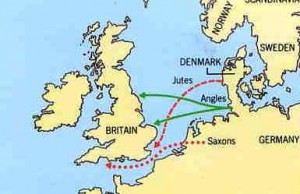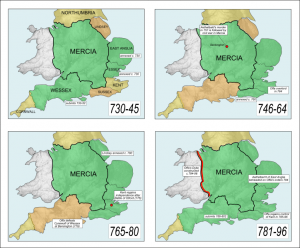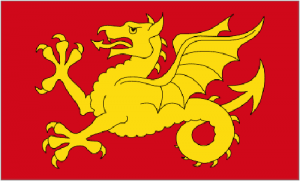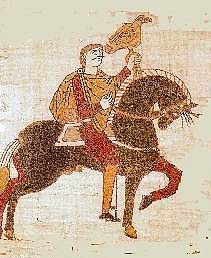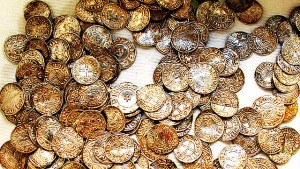Anglo-Saxon Swanbourne AD600-1066
NEWLY REVISED – Historical background – how Swanbourne was established in England.
Overview of events summarised by Clive Rodgers
The Anglo-Saxon Chronicles inform us of Angles and Saxons being invited to assist in keeping off fierce Pictish tribesmen from Scotland, as the Roman Army had departed to defend Rome. The Angles were from Schleswig on the Danish/German border today, including the town called Angeln to this day. Further to the west along the coast of Northern Germany and the Netherlands today is Frisia. The Frisian language survives today in parts of Frisia (spoken by c.50,000 people), and this is very close if not identical to Old English.
The Saxons migrated from Frisia, and there was a general migration from the coastal regions from southern Denmark through North Germany, the Netherlands and Belgium. Tis has been linked to sea level rises and crop failures.
Most of these people spoke Old Frisian (Old English). The East of England provided excellent, readily available farmland, and some English speaking communities were already here derived from mercenaries employed to keep out raids from the northern Picts. When money ran out, the Britons paid them in farmland instead.
Swanbourne is established
The establishment of our village probably by South Angles or East Angles may have been accomplished by around the middle of the 7th Century. The name of the village is discussed elsewhere.
The West Saxons moved up from the south under King Cerdic, and in 577, they took control of Aylesbury and Oxford.
The county name of Buckinghamshire is Anglo-Saxon in origin and means the district of Bucca’s home. The name Bucca, refers to a chief or landowner in Buckingham. A mix of different peoples subsequently contributed to the make up of the central Kingdom of Mercia, including Swanbourne and Winslow.
The county has thus been named Buckinghamshire since about the 12th century, but previously was a subdivision of the Kingdom of Mercia (585 – 919), and part of the Empire of Offa, the greatest King of Mercia.
In 792, King Offa of Mercia is thought to have granted Winslow and some neighbouring villages to the abbey of St Albans. In demarking the extent of this gift, it refers to the stream dividing Swanbourne from Granborough. Hence, Swanbourne was most likely a distinct settlement by 793.
The Winslow Charter of King Offa offering lands to the Abbey of St Albans mentions ‘Suanaburna’ for the first time. Reference as a PDF:- Baines, A.H.J., The Winslow charter of 792 and the boundaries of Granborough, Records of Bucks 22 (1980), 1-18
The Unification of England and succession of Kings
By the Ninth Century, Wessex and English Mercia suffered many attacks by Vikings. By the start of the Tenth Century, from Wessex, King Alfred and his son and successor Edward the Elder expanded North, annexing London, Oxford and the surrounding area, (probably including Middlesex, Hertfordshire, Buckinghamshire and Oxfordshire) from Mercia to Wessex. Many of the reigns of English Kings were short lived and characterised by instability. There was a strong Scandinavian influence which only ended after the accession of William of Normandy.
The succession from King Offa to William 1st was as follows:-
King Offa (757-796) introduced the silver penny as coinage. He is known to have had a hunting lodge on the edge of Winslow, some two miles from Swanbourne:-
Egbert (802-829) of Wessex gained domination in southern and Central England after the decline of King Offa’s Mercia.
Ethelwulf was the son of Egbert. He succeeded his father in 839. At Ethelwulf’s request, his four sons each became king in turn as follows:- Ethelwulf (839-856); Ethelbald (856-860); Ethelbert (860-866); Ethelred (876-861).
Alfred the Great (871-899) was the first king of all England. The Kingdom of Wessex had taken over the other English kingdoms to unification in to a single Kingdom of England by 927. The original language of the Celtic people of Bucks was Old Welsh. With their progressive assimilation, it was almost totally replaced by Old English.
Edward the Elder (899-924) was able to establish an administration for the kingdom of England, whilst also obtaining the allegiance of Danes, Scots and Britons.
Athelstan (924-939) took York from the Danes and forced the submission of king Constantine of Scotland and of the northern kings.
Edmund 1st (939-946) was half brother of Athelstan, taking the throne because Athelstan had no children. He was murdered at a feast in his own hall.
Edred (946-955) was brother of Edmund 1st, also bringing up his son to be King.
Edwy (955-959) was aged 13 on his succession to the throne, and died aged 17.
Edgar (959-975) introduced uniform coinage throughout the Kingdom.
Edward 2nd (975-979) Edward was murdered in 979 at Corfe, Dorset, by his half-brother’s supporters.
Ethelred 2nd (979-1013) was known as ‘The Unready’. He fled to Normandy when the Viking Sweyn of Denmark dispossessed him. Ethelred returned to rule after Sweyn’s death in 1014.
Sweyn (1013-1014) was the son of a Danish King who successfully conquered most of England, but was only recognosed as King for a year before his death in 1014.
Edmund 2nd (1016) was known as ‘the Ironside’ made himself ruler of ‘Danelaw’ for 6 months before being defeated by his father, Canute.
Canute (1016-1035) became King of England, Denmark and Norway.
Harold Harefoot (1035-1040) was the son of Canute and his first wife, known as Elfgifu.
Hardicanute (1035-1042) succeeded to the throne after the death of his brother, Harold Harefoot.
Edward 3rd (1042-1066) was the surviving son of Ethelred 2nd and his second wife, Emma of Normandy.
Harold 2nd (Jan-Oct. 1066) was Edward’s brother-in-law and Earl of Wessex. He had no royal blood, and feared rival claims from William Duke of Normandy (Edward’s cousin through his mother’s Norman origin) and the King of Norway, so was crowned in Westminster Abbey on 6 January 1066, the day after Edward’s death.
Swanbourne statistics immediately before 1066 (from the Domesday Book) indicate Swanbourne to be unusual in that it it did not have a single manorial overlord but was divided amongst 5 owners at the end of the Anglo-Saxon period. The first manor was the land already in the ownership of Earl Harold. At the start of 1066, Brixtuin, a Thane of King Edward and Almar, a Vassel of Earl Harold held a second manor. A third manor was held by two thanes, Alward and Alui, and a fourth manor was held by Swein, a vassal of Esger the constable’s man.
The Victorian historian Arthur Clear suggested that the name of Swanbourne could have been derived from the Danish name Swein, linked to Anglo-Saxon historical events. All the evidence suggests that North Bucks was important during late Anglo-Saxon times, as the town of Buckingham had the royal mint. Silver pennies were produced there for nearly one hundred years. On December 23rd, 2014, a metal detectors club discovered a buried hoard of several thousand silver pennies at Padbury, 6.4 miles from Swanbourne. They are valued as being worth over £1,000,000, and were produced during the reigns of King Cnut and Ethelred ‘The Unready’.
There are 5 sequential entries for Swanbourne in the Domesday book itself. These entries refer to the ownership before and after the Norman Conquest.
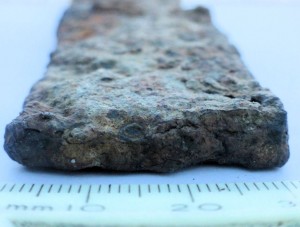
Remains of an Anglo Saxon hunting knife, known as a seax, pictured end-on, discovered in Swanbourne in 2012. The circular structures seen are indicative of it being forged by hammering together a cluster of heated iron rods.
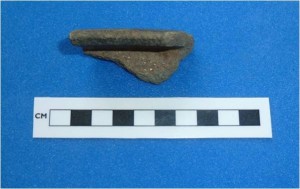
Late Saxon cooking pottery fragment found by in Charlton Close (2010) dates to about 1050 AD and would most likely have been used through the Saxo-Norman transition.
The largest concentration of people in the village were probably around the Church, the hill top and the ridge around it; possibly also towards the direction of the stream down Station Road.
At present, Anglo-Saxon Pottery as well as a possible Seax (hunting knife) have been found in Swanbourne. The proved archaeological sites are at the Church graveyard and at Charlton Close, off Station Road. It seems quite likely that more finds will be made in the future.
RETURN to the Historical Events Category
This post has 3 Simple Fields-fields attached. Show fields.


